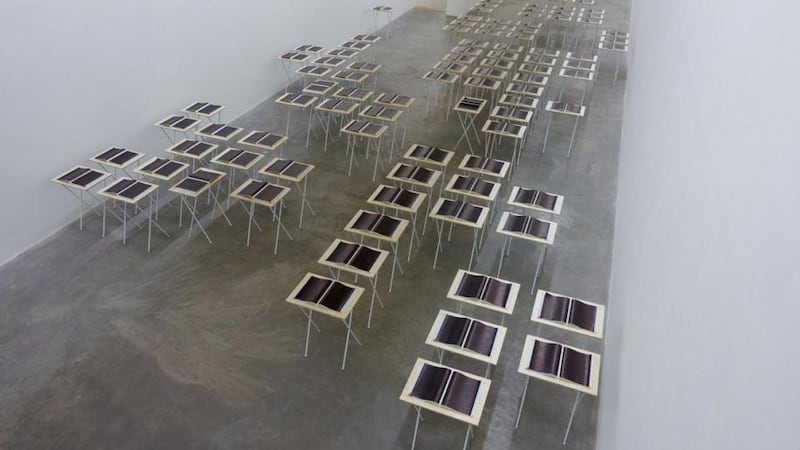What is it?
Atlas is a sculptural installation created by Kathy Prendergast in 2016.
How was it done?

In making Atlas, Prendergast acquired 100 copies of an edition of the AA Road Atlas of Europe. Then, working her way through sequential double-page spreads from copy to copy and using Indian ink, she painted over the open spaces and all the geographical information, graphic, textual and numeric, leaving only apparently random patterns of bright dots: these beacons, like stars in the night sky in appearance, are centres of habitation, the cities and towns. Each amended atlas was paired with and, for exhibition, displayed on a small trestle table. The 100 tables can be arranged in varying order depending on the dictates of venue and the artistic and curatorial choices made.
Where can I see it?
Atlas is currently included in A Slice Through the World: Contemporary Artists' Drawings, at Modern Art Oxford (until September 9th). Produced by Modern Art Oxford in collaboration with Drawing Room, London, the show includes recent works by 14 international artists for whom drawing remains central. The intention is to demonstrate the continued significance of drawing in the digital age, in particular drawing as a slow, considered process, in contrast to the instantaneous nature of the most popular forms of digital imaging. Nidhal Chamekh, Kate Davis, David Haines, Wura-Natasha Ogunji, Lucy Skaer and Barbara Walker are among the artists also included.
Is it a typical work by the artist?
One of Ireland's leading contemporary artists, Prendergast's work has always resisted easy categorisation and labels. But Atlas is typical in its quiet ambition and conceptual richness – also its emphasis on a patient process of making. Besides which, the idea of mapping has been of interest to Prendergast from early on.
The first work that established her reputation was a series of cartographic representations of a woman's body – and being – as landscape, beautiful works and a metaphoric representation of attitudes towards and demands made on women. Her City Drawings (in the Irish Museum of Modern Art collection) are based on small, intricate drawings of maps of capital cities throughout the world, in which the great urban centres become diminutive, vulnerable-looking organic forms. An awareness of the universal contained in the personal has been increasingly apparent in works that allude to the cyclical and generational nature of life, the emotional intensity of common human experiences and a collective sense of identity.
Atlas was made at a time when Europe became a largely inaccessible haven for populations in crisis. As an entity, the work is a hymn to our shared humanity. It offers a view of human beings as isolated creatures and communities who find themselves with the gift of life on a small planet speeding through, as Pascal put it, the eternal silence of those infinite spaces. Prendergast subtly draws our attention to this reality at a time when borders, divisions, exclusion and sectarianism are all to the fore.


















